Cross-Cultural Practice and Racism: Amina's Case Report Analysis
VerifiedAdded on 2022/09/07
|13
|3123
|20
Report
AI Summary
This report examines the cross-cultural practices, racism, and discriminatory behaviors experienced by Amina, an Afghani refugee, within the context of the Hopetown Community Health Centre. It analyzes the impact of cultural insensitivity, communication barriers, and lack of trauma-informed care on Amina's well-being. The report explores the various forms of racism, including institutional and cultural, and their effects on refugees. It highlights the importance of understanding the challenges refugees face, such as trauma, social isolation, and language barriers. The report provides recommendations for improving cross-cultural practices, including staff training, interpreter services, and the implementation of trauma-informed care to better serve culturally and linguistically diverse (CALD) populations. The report emphasizes the need for ethical and legally sound practices, referencing relevant legislation and guidelines to promote equitable and effective healthcare delivery. It also highlights the importance of considering the specific needs of refugees and providing comprehensive support to address domestic violence and mental health concerns, ultimately aiming to improve the quality of life for vulnerable individuals like Amina.
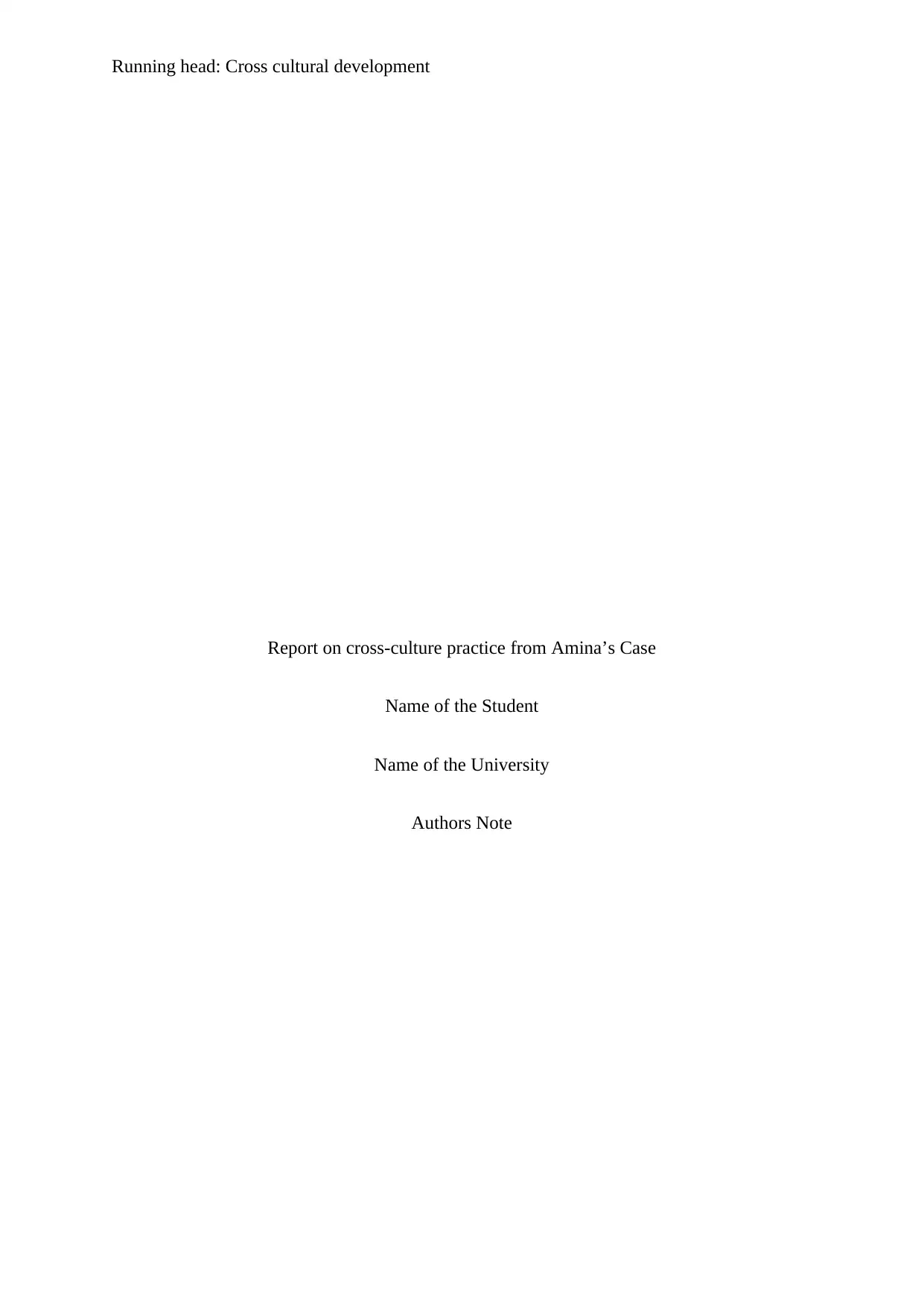
Running head: Cross cultural development
Report on cross-culture practice from Amina’s Case
Name of the Student
Name of the University
Authors Note
Report on cross-culture practice from Amina’s Case
Name of the Student
Name of the University
Authors Note
Paraphrase This Document
Need a fresh take? Get an instant paraphrase of this document with our AI Paraphraser
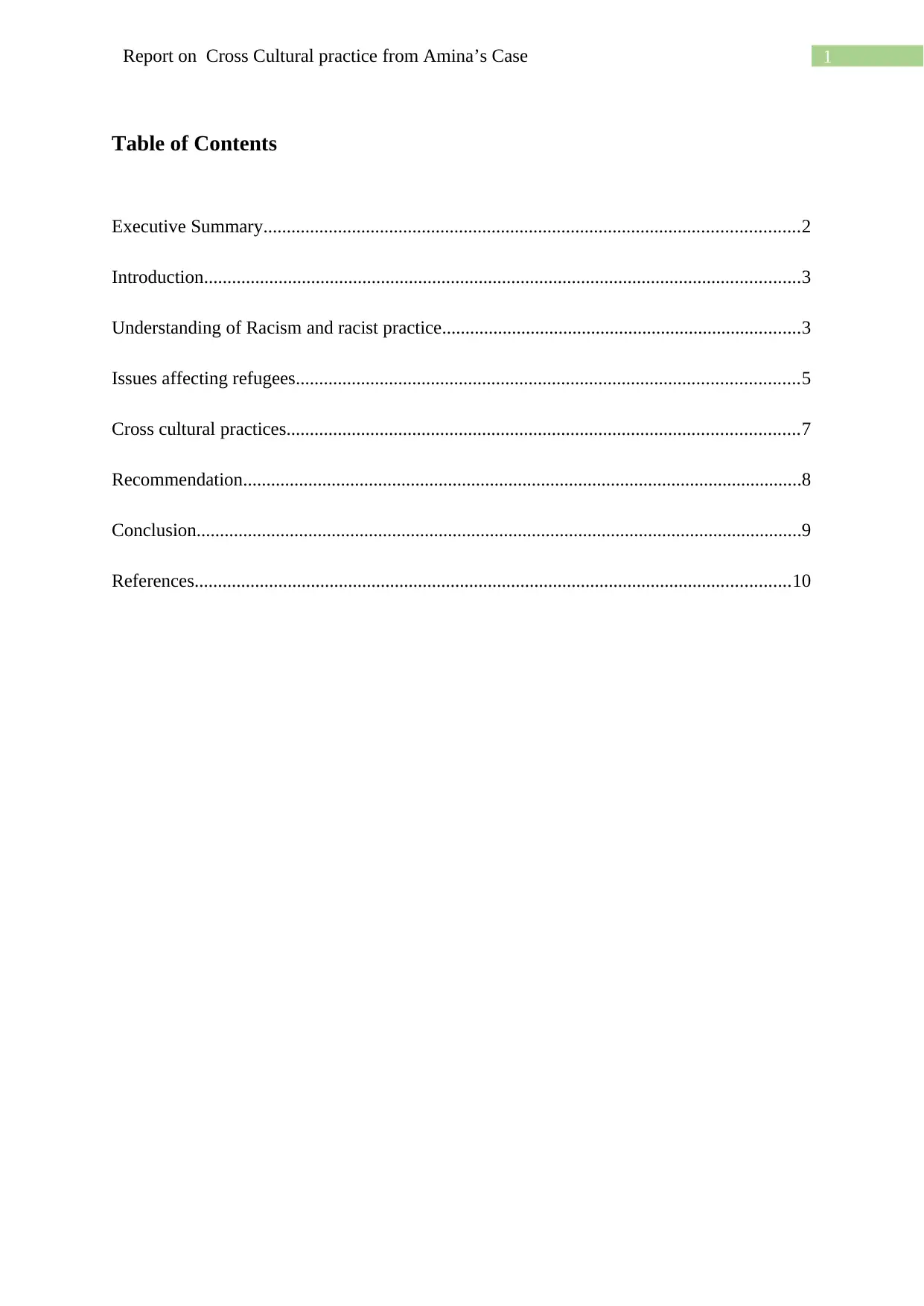
1Report on Cross Cultural practice from Amina’s Case
Table of Contents
Executive Summary...................................................................................................................2
Introduction................................................................................................................................3
Understanding of Racism and racist practice.............................................................................3
Issues affecting refugees............................................................................................................5
Cross cultural practices..............................................................................................................7
Recommendation........................................................................................................................8
Conclusion..................................................................................................................................9
References................................................................................................................................10
Table of Contents
Executive Summary...................................................................................................................2
Introduction................................................................................................................................3
Understanding of Racism and racist practice.............................................................................3
Issues affecting refugees............................................................................................................5
Cross cultural practices..............................................................................................................7
Recommendation........................................................................................................................8
Conclusion..................................................................................................................................9
References................................................................................................................................10
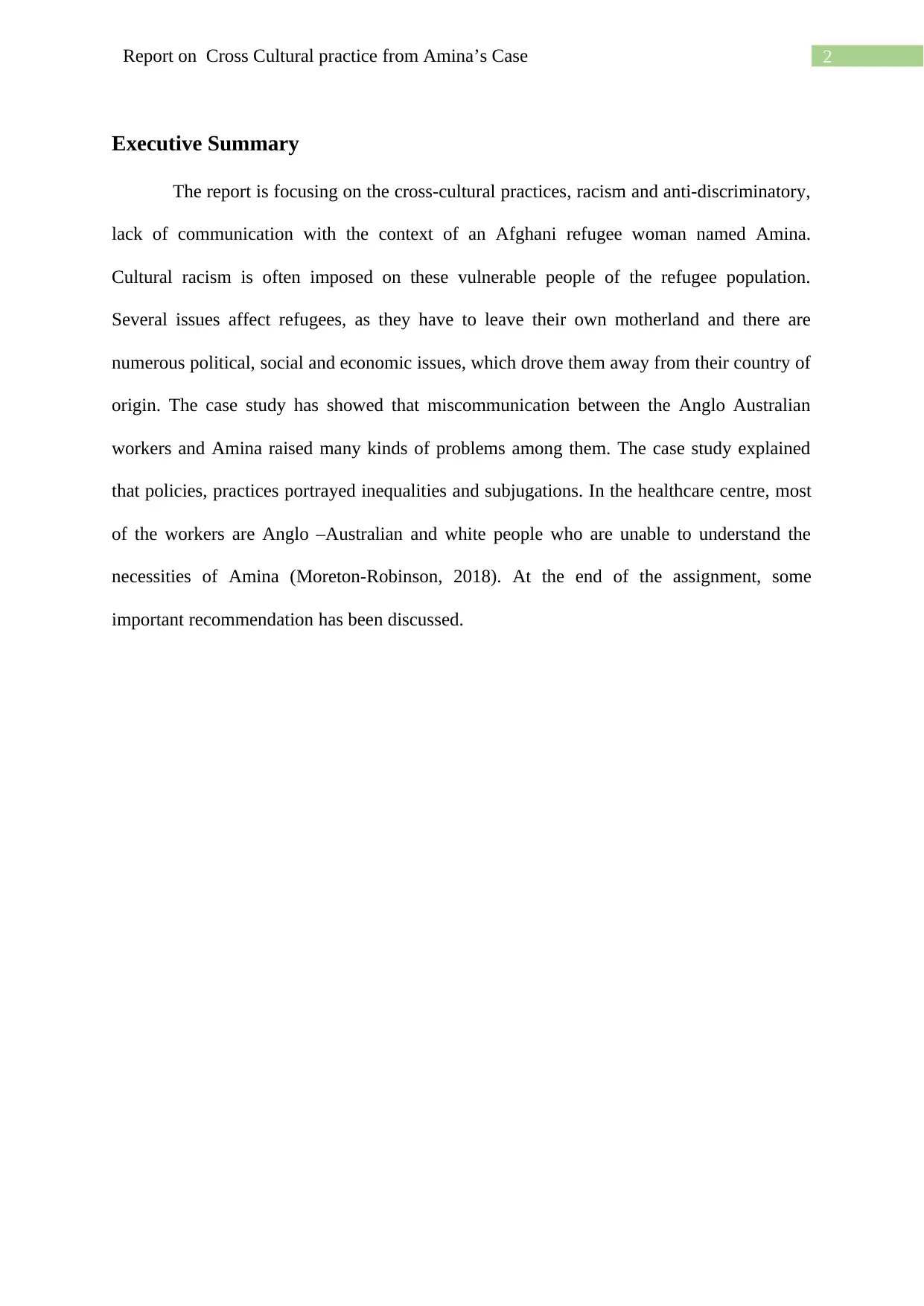
2Report on Cross Cultural practice from Amina’s Case
Executive Summary
The report is focusing on the cross-cultural practices, racism and anti-discriminatory,
lack of communication with the context of an Afghani refugee woman named Amina.
Cultural racism is often imposed on these vulnerable people of the refugee population.
Several issues affect refugees, as they have to leave their own motherland and there are
numerous political, social and economic issues, which drove them away from their country of
origin. The case study has showed that miscommunication between the Anglo Australian
workers and Amina raised many kinds of problems among them. The case study explained
that policies, practices portrayed inequalities and subjugations. In the healthcare centre, most
of the workers are Anglo –Australian and white people who are unable to understand the
necessities of Amina (Moreton-Robinson, 2018). At the end of the assignment, some
important recommendation has been discussed.
Executive Summary
The report is focusing on the cross-cultural practices, racism and anti-discriminatory,
lack of communication with the context of an Afghani refugee woman named Amina.
Cultural racism is often imposed on these vulnerable people of the refugee population.
Several issues affect refugees, as they have to leave their own motherland and there are
numerous political, social and economic issues, which drove them away from their country of
origin. The case study has showed that miscommunication between the Anglo Australian
workers and Amina raised many kinds of problems among them. The case study explained
that policies, practices portrayed inequalities and subjugations. In the healthcare centre, most
of the workers are Anglo –Australian and white people who are unable to understand the
necessities of Amina (Moreton-Robinson, 2018). At the end of the assignment, some
important recommendation has been discussed.
⊘ This is a preview!⊘
Do you want full access?
Subscribe today to unlock all pages.

Trusted by 1+ million students worldwide

3Report on Cross Cultural practice from Amina’s Case
Introduction
Cross-cultural practices can be observed in the population of refugees. Different
circumstances can influence the mental health of people of these communities. This
assignment will focus on the case study of a refugee woman named Amina and the
consequences she faced in her life. This assignment will give insight on socio-cultural
practices and discriminatory behaviours in the societal context. Racism can be observed in
different situations of society such as institutional, social and individual level. Anti-
discriminatory can prevent racisms and racists practices in society. Lack of communication
due to cultural diversity can arise issues in the lives of refugees. Recommendations related to
the Child Protection Service and treatments for recovering trauma will be discussed in this
essay. The aim of this essay is to analyse how racisms and other social issues can affect lives
of people of a refugee community. The essay will argue on provided cross-cultural practices
and awareness to Amina and will counter assumptions, which have been made on her
appearance, ethnicity, and mental health condition and communication barriers. The essay
will suggest the recommendations for better interventions in different conditions.
Understanding of Racism and racist practice
Different types of racisms can be observed in society such as individual,
interpersonal, institutional, cultural, structural racism. Institutional racism is a type of racism,
which is observed in social and political institutions against a group of people (Griffith et al.,
2007). Due to institutional racism, one can face issues regarding wealth, criminal justice,
employment, healthcare, education and housing. Unequal distribution of policies and
opportunities function against the minority groups. Ethics are regarded as the standards and
the policies which help to guide the practices of the morals and value systems of workers.
Cultural and ethical practices can be considered as base of the preventive measures against
Introduction
Cross-cultural practices can be observed in the population of refugees. Different
circumstances can influence the mental health of people of these communities. This
assignment will focus on the case study of a refugee woman named Amina and the
consequences she faced in her life. This assignment will give insight on socio-cultural
practices and discriminatory behaviours in the societal context. Racism can be observed in
different situations of society such as institutional, social and individual level. Anti-
discriminatory can prevent racisms and racists practices in society. Lack of communication
due to cultural diversity can arise issues in the lives of refugees. Recommendations related to
the Child Protection Service and treatments for recovering trauma will be discussed in this
essay. The aim of this essay is to analyse how racisms and other social issues can affect lives
of people of a refugee community. The essay will argue on provided cross-cultural practices
and awareness to Amina and will counter assumptions, which have been made on her
appearance, ethnicity, and mental health condition and communication barriers. The essay
will suggest the recommendations for better interventions in different conditions.
Understanding of Racism and racist practice
Different types of racisms can be observed in society such as individual,
interpersonal, institutional, cultural, structural racism. Institutional racism is a type of racism,
which is observed in social and political institutions against a group of people (Griffith et al.,
2007). Due to institutional racism, one can face issues regarding wealth, criminal justice,
employment, healthcare, education and housing. Unequal distribution of policies and
opportunities function against the minority groups. Ethics are regarded as the standards and
the policies which help to guide the practices of the morals and value systems of workers.
Cultural and ethical practices can be considered as base of the preventive measures against
Paraphrase This Document
Need a fresh take? Get an instant paraphrase of this document with our AI Paraphraser

4Report on Cross Cultural practice from Amina’s Case
racisms (Miller & Garran, 2017). People of a refugee population often face some cultural
discrimination and prejudices. Their behaviours are influenced with their beliefs and lack of
understanding about new socio-cultural background. People of refugee population mostly
placed in workers’ position (Hufton & Raven, 2016). They might fail to accept or see new
work culture due to lack of training. Lack of training reduces the confidence among the
refugee workers. Racism is a complex and embedded behaviour, which can affect societal
and cultural aspect of a person. Language can act as a barrier for people of refugee
community. In the case study, Amina could not communicate in English properly and due to
this, she cannot express herself in front of others. As discussed above, cultural racism is
often imposed on these vulnerable people of the refugee populations. The concept cultural
racism can discriminate between different groups of the society by giving someone
superiority. Cultural racism is based on racial and ethnic differences. Individual racism can
be referred as a form of racial discrimination for individual by conscious or unconscious and
personal prejudices of people (Kivel, 2017). Individual racism can be connected to broader
socio-economic histories. Systemic racism supports the concepts of individual racism. The
provided services were not enough for her as most of the workers were white and Anglo-
Australian. The workers were unable to give her adequate information. The case study
explained that policies, practices portrayed inequalities and subjugations. In the healthcare
centre most of the workers are Anglo –Australian and white people who are unable to
understand the necessities of Amina (Moreton-Robinson, 2018). The healthcare sectors
workers showed some behaviours, which did not support anti-discriminating actions. For
example usage of translators, pathologising her marriage, showing indifference when she
complained about her husband’s indifference towards her. She had no access of her child due
to her behavioural issues and she faced legal obstacles to get her child. These adversities
made her feel powerless and vulnerable.
racisms (Miller & Garran, 2017). People of a refugee population often face some cultural
discrimination and prejudices. Their behaviours are influenced with their beliefs and lack of
understanding about new socio-cultural background. People of refugee population mostly
placed in workers’ position (Hufton & Raven, 2016). They might fail to accept or see new
work culture due to lack of training. Lack of training reduces the confidence among the
refugee workers. Racism is a complex and embedded behaviour, which can affect societal
and cultural aspect of a person. Language can act as a barrier for people of refugee
community. In the case study, Amina could not communicate in English properly and due to
this, she cannot express herself in front of others. As discussed above, cultural racism is
often imposed on these vulnerable people of the refugee populations. The concept cultural
racism can discriminate between different groups of the society by giving someone
superiority. Cultural racism is based on racial and ethnic differences. Individual racism can
be referred as a form of racial discrimination for individual by conscious or unconscious and
personal prejudices of people (Kivel, 2017). Individual racism can be connected to broader
socio-economic histories. Systemic racism supports the concepts of individual racism. The
provided services were not enough for her as most of the workers were white and Anglo-
Australian. The workers were unable to give her adequate information. The case study
explained that policies, practices portrayed inequalities and subjugations. In the healthcare
centre most of the workers are Anglo –Australian and white people who are unable to
understand the necessities of Amina (Moreton-Robinson, 2018). The healthcare sectors
workers showed some behaviours, which did not support anti-discriminating actions. For
example usage of translators, pathologising her marriage, showing indifference when she
complained about her husband’s indifference towards her. She had no access of her child due
to her behavioural issues and she faced legal obstacles to get her child. These adversities
made her feel powerless and vulnerable.

5Report on Cross Cultural practice from Amina’s Case
Issues affecting refugees
Several issues affect refugees, as they have to leave their own motherland and there
are numerous political, social and economic issues, which drove them away from their
country of origin. Afghanistan has undergone years of war, invasion of foreign troops and
faced deterioration of security threat (Mungai, 2014). People become refugee due to unstable
conditions of their nations and face many challenges over the times. Amina faced all of the
above-discussed situations during migration. She was under Taliban reign of 1996 to 2001.
She has undergone terrible trauma. During that period, Taliban misplaced over 100,000
Afghans as the result of war and inequality. Oppression and inequality towards women are
one of the reasons of misery among the women of Afghanistan. These conditions induce
trauma reaction in Amina. Clinical experts explained that Amina was suffered from anxiety
depression and behavioural issues and various mental illness. They experience social
isolation, depression, and anxiety. These vulnerable people experience lack of preliminary
services regarding healthcare, education, nutrition and safety. They are targeted for torture,
domestic violence, rapes and other socio-political crimes. Separation from family,
homelessness, identity crisis are very common in refugee population. Resettlement brings
experience of loss of dignity, guilt and anxiety for hearing news from back home. Amina
struggled for resettlement with her husband, sister-in-law and child. Her immediate family
was not supportive towards her. During the time of resettlement. Amina was a victim of
domestic violence and during migration and she faced several adverse situations. She
received news of bomb blast of her family in refugee camp. After receiving this news, she
faced mental health problem. Therefore, she showed symptoms of behavioural issues, anxiety
and severe trauma. Re-traumatisation can be triggered even after resettled in a safer country
(den Otter et al., 2019). Treatment for patients suffering from trauma requires understanding
of background, experience and sufferings of those affected people. Trauma informed
Issues affecting refugees
Several issues affect refugees, as they have to leave their own motherland and there
are numerous political, social and economic issues, which drove them away from their
country of origin. Afghanistan has undergone years of war, invasion of foreign troops and
faced deterioration of security threat (Mungai, 2014). People become refugee due to unstable
conditions of their nations and face many challenges over the times. Amina faced all of the
above-discussed situations during migration. She was under Taliban reign of 1996 to 2001.
She has undergone terrible trauma. During that period, Taliban misplaced over 100,000
Afghans as the result of war and inequality. Oppression and inequality towards women are
one of the reasons of misery among the women of Afghanistan. These conditions induce
trauma reaction in Amina. Clinical experts explained that Amina was suffered from anxiety
depression and behavioural issues and various mental illness. They experience social
isolation, depression, and anxiety. These vulnerable people experience lack of preliminary
services regarding healthcare, education, nutrition and safety. They are targeted for torture,
domestic violence, rapes and other socio-political crimes. Separation from family,
homelessness, identity crisis are very common in refugee population. Resettlement brings
experience of loss of dignity, guilt and anxiety for hearing news from back home. Amina
struggled for resettlement with her husband, sister-in-law and child. Her immediate family
was not supportive towards her. During the time of resettlement. Amina was a victim of
domestic violence and during migration and she faced several adverse situations. She
received news of bomb blast of her family in refugee camp. After receiving this news, she
faced mental health problem. Therefore, she showed symptoms of behavioural issues, anxiety
and severe trauma. Re-traumatisation can be triggered even after resettled in a safer country
(den Otter et al., 2019). Treatment for patients suffering from trauma requires understanding
of background, experience and sufferings of those affected people. Trauma informed
⊘ This is a preview!⊘
Do you want full access?
Subscribe today to unlock all pages.

Trusted by 1+ million students worldwide

6Report on Cross Cultural practice from Amina’s Case
practices are organisational structures and frameworks, which involve concepts, recognition
of conditions and responses towards patients for curing impacts of all type of trauma. Safety,
choice, collaboration, trust and empowerment of patients are five main principles for trauma
informed care. These principles ensures physical and emotional safety of a patient. TIC is a
strength-based framework with the understanding and responsiveness of impact of trauma
(Bowles, 2001). TIC supports CALD people as the framework is specially designed to
examine culturally competent ways to recognise issues and dealing with them (Cyril et al.,
2017). The frameworks emphasizes physical, emotional and psychological wellbeing and
safety for provider and survivor. This helps to rebuild the sense of control and resolve
identity crisis in survivors. Clinical unit explains that western models of counselling are not
as fruitful as integrated approaches, which includes family and community. QPASTT is a
program, which provides culturally sensitive services, which are flexible to cure trauma and
negative experiences of the survivors (Glen, Onsando & Kearney, 2015). This program
includes group session with survivor’s treatment with multicultural approach and advocacy to
provide legal assistance for refugee people. Unfortunately, Amina did not have the
opportunity to avail TIC services after her hospital discharge. This is an example of lack of
care and support network. TIC practices are designed in different traditional models and
interventions with various frameworks of treatment to restore the sense of control (Medlin et
al., 2017). Different levels of intervention such as functioning with families and
individuals, group and community, social policy development were proposed by the
STARTTS in NSW (www1.health.nsw.gov.au. 2019, Healthy Culturally Diverse
Communities 2012–2016). These interventions are highly equipped from CALD (Culturally
and Linguistically Diverse) background. CALD workers can connect with these survivors in
a better way. However in Amina's situation the workers were not enough competent and were
unable to understand impact of trauma in her behaviour. They labelled her condition as
practices are organisational structures and frameworks, which involve concepts, recognition
of conditions and responses towards patients for curing impacts of all type of trauma. Safety,
choice, collaboration, trust and empowerment of patients are five main principles for trauma
informed care. These principles ensures physical and emotional safety of a patient. TIC is a
strength-based framework with the understanding and responsiveness of impact of trauma
(Bowles, 2001). TIC supports CALD people as the framework is specially designed to
examine culturally competent ways to recognise issues and dealing with them (Cyril et al.,
2017). The frameworks emphasizes physical, emotional and psychological wellbeing and
safety for provider and survivor. This helps to rebuild the sense of control and resolve
identity crisis in survivors. Clinical unit explains that western models of counselling are not
as fruitful as integrated approaches, which includes family and community. QPASTT is a
program, which provides culturally sensitive services, which are flexible to cure trauma and
negative experiences of the survivors (Glen, Onsando & Kearney, 2015). This program
includes group session with survivor’s treatment with multicultural approach and advocacy to
provide legal assistance for refugee people. Unfortunately, Amina did not have the
opportunity to avail TIC services after her hospital discharge. This is an example of lack of
care and support network. TIC practices are designed in different traditional models and
interventions with various frameworks of treatment to restore the sense of control (Medlin et
al., 2017). Different levels of intervention such as functioning with families and
individuals, group and community, social policy development were proposed by the
STARTTS in NSW (www1.health.nsw.gov.au. 2019, Healthy Culturally Diverse
Communities 2012–2016). These interventions are highly equipped from CALD (Culturally
and Linguistically Diverse) background. CALD workers can connect with these survivors in
a better way. However in Amina's situation the workers were not enough competent and were
unable to understand impact of trauma in her behaviour. They labelled her condition as
Paraphrase This Document
Need a fresh take? Get an instant paraphrase of this document with our AI Paraphraser
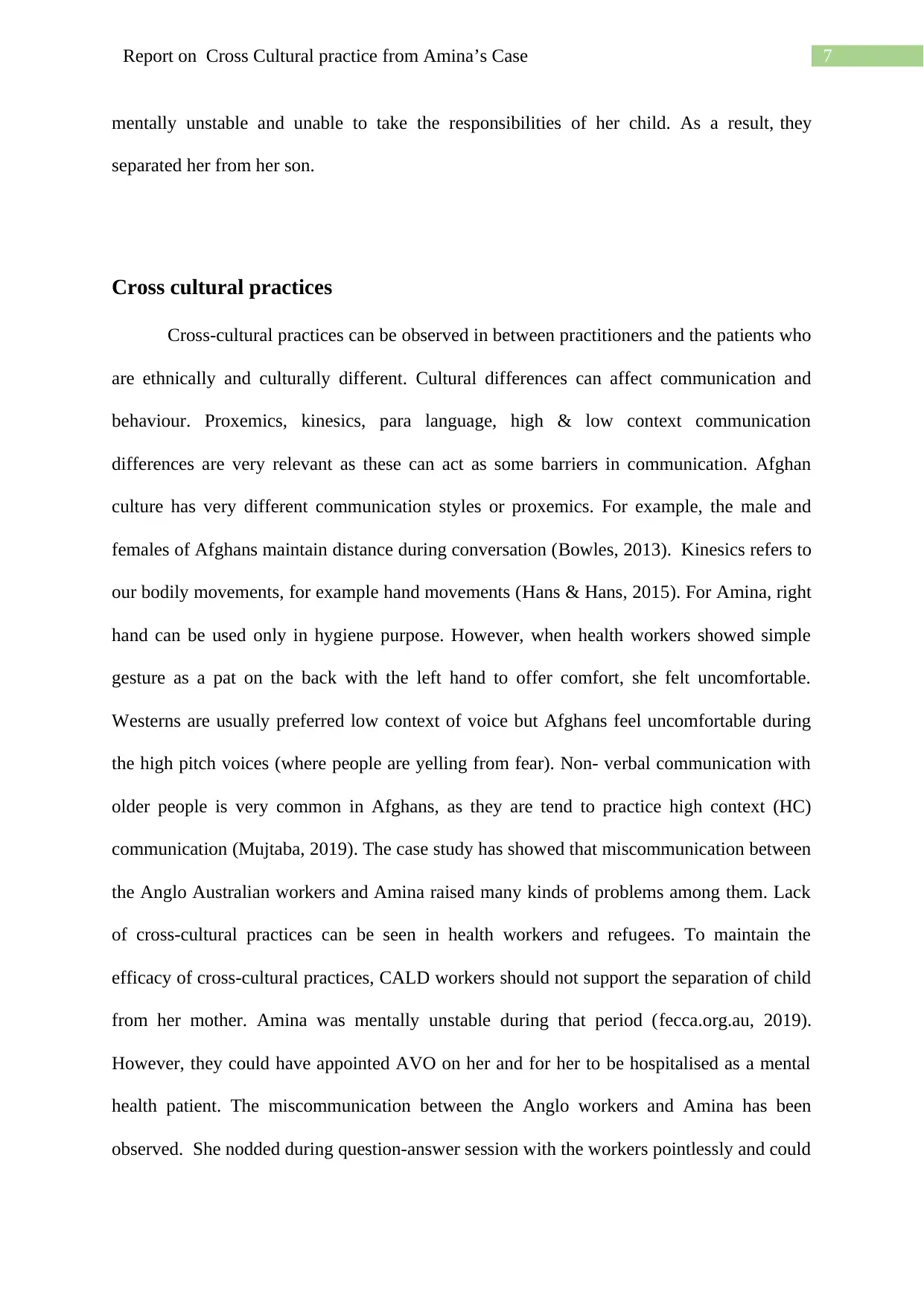
7Report on Cross Cultural practice from Amina’s Case
mentally unstable and unable to take the responsibilities of her child. As a result, they
separated her from her son.
Cross cultural practices
Cross-cultural practices can be observed in between practitioners and the patients who
are ethnically and culturally different. Cultural differences can affect communication and
behaviour. Proxemics, kinesics, para language, high & low context communication
differences are very relevant as these can act as some barriers in communication. Afghan
culture has very different communication styles or proxemics. For example, the male and
females of Afghans maintain distance during conversation (Bowles, 2013). Kinesics refers to
our bodily movements, for example hand movements (Hans & Hans, 2015). For Amina, right
hand can be used only in hygiene purpose. However, when health workers showed simple
gesture as a pat on the back with the left hand to offer comfort, she felt uncomfortable.
Westerns are usually preferred low context of voice but Afghans feel uncomfortable during
the high pitch voices (where people are yelling from fear). Non- verbal communication with
older people is very common in Afghans, as they are tend to practice high context (HC)
communication (Mujtaba, 2019). The case study has showed that miscommunication between
the Anglo Australian workers and Amina raised many kinds of problems among them. Lack
of cross-cultural practices can be seen in health workers and refugees. To maintain the
efficacy of cross-cultural practices, CALD workers should not support the separation of child
from her mother. Amina was mentally unstable during that period (fecca.org.au, 2019).
However, they could have appointed AVO on her and for her to be hospitalised as a mental
health patient. The miscommunication between the Anglo workers and Amina has been
observed. She nodded during question-answer session with the workers pointlessly and could
mentally unstable and unable to take the responsibilities of her child. As a result, they
separated her from her son.
Cross cultural practices
Cross-cultural practices can be observed in between practitioners and the patients who
are ethnically and culturally different. Cultural differences can affect communication and
behaviour. Proxemics, kinesics, para language, high & low context communication
differences are very relevant as these can act as some barriers in communication. Afghan
culture has very different communication styles or proxemics. For example, the male and
females of Afghans maintain distance during conversation (Bowles, 2013). Kinesics refers to
our bodily movements, for example hand movements (Hans & Hans, 2015). For Amina, right
hand can be used only in hygiene purpose. However, when health workers showed simple
gesture as a pat on the back with the left hand to offer comfort, she felt uncomfortable.
Westerns are usually preferred low context of voice but Afghans feel uncomfortable during
the high pitch voices (where people are yelling from fear). Non- verbal communication with
older people is very common in Afghans, as they are tend to practice high context (HC)
communication (Mujtaba, 2019). The case study has showed that miscommunication between
the Anglo Australian workers and Amina raised many kinds of problems among them. Lack
of cross-cultural practices can be seen in health workers and refugees. To maintain the
efficacy of cross-cultural practices, CALD workers should not support the separation of child
from her mother. Amina was mentally unstable during that period (fecca.org.au, 2019).
However, they could have appointed AVO on her and for her to be hospitalised as a mental
health patient. The miscommunication between the Anglo workers and Amina has been
observed. She nodded during question-answer session with the workers pointlessly and could
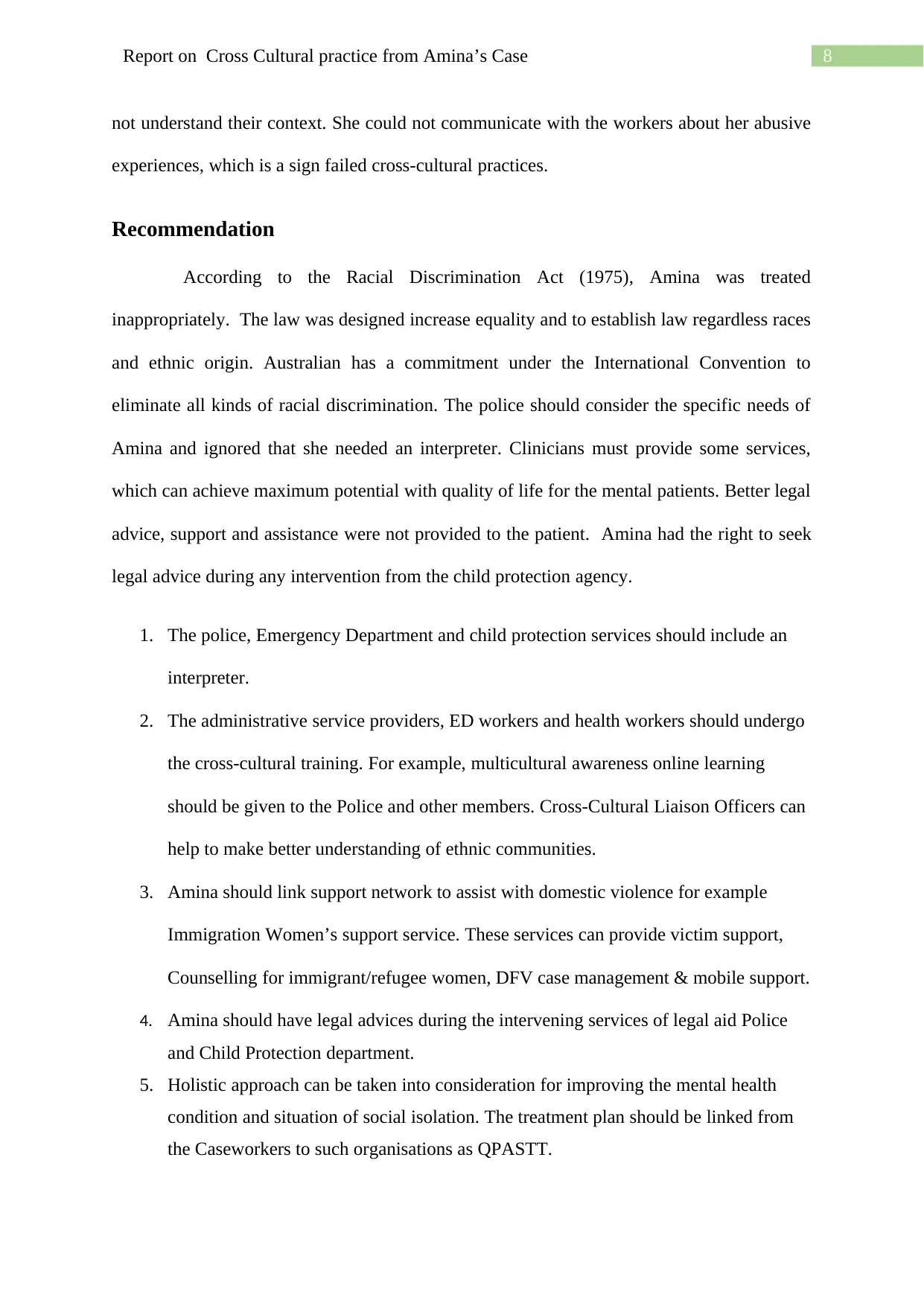
8Report on Cross Cultural practice from Amina’s Case
not understand their context. She could not communicate with the workers about her abusive
experiences, which is a sign failed cross-cultural practices.
Recommendation
According to the Racial Discrimination Act (1975), Amina was treated
inappropriately. The law was designed increase equality and to establish law regardless races
and ethnic origin. Australian has a commitment under the International Convention to
eliminate all kinds of racial discrimination. The police should consider the specific needs of
Amina and ignored that she needed an interpreter. Clinicians must provide some services,
which can achieve maximum potential with quality of life for the mental patients. Better legal
advice, support and assistance were not provided to the patient. Amina had the right to seek
legal advice during any intervention from the child protection agency.
1. The police, Emergency Department and child protection services should include an
interpreter.
2. The administrative service providers, ED workers and health workers should undergo
the cross-cultural training. For example, multicultural awareness online learning
should be given to the Police and other members. Cross-Cultural Liaison Officers can
help to make better understanding of ethnic communities.
3. Amina should link support network to assist with domestic violence for example
Immigration Women’s support service. These services can provide victim support,
Counselling for immigrant/refugee women, DFV case management & mobile support.
4. Amina should have legal advices during the intervening services of legal aid Police
and Child Protection department.
5. Holistic approach can be taken into consideration for improving the mental health
condition and situation of social isolation. The treatment plan should be linked from
the Caseworkers to such organisations as QPASTT.
not understand their context. She could not communicate with the workers about her abusive
experiences, which is a sign failed cross-cultural practices.
Recommendation
According to the Racial Discrimination Act (1975), Amina was treated
inappropriately. The law was designed increase equality and to establish law regardless races
and ethnic origin. Australian has a commitment under the International Convention to
eliminate all kinds of racial discrimination. The police should consider the specific needs of
Amina and ignored that she needed an interpreter. Clinicians must provide some services,
which can achieve maximum potential with quality of life for the mental patients. Better legal
advice, support and assistance were not provided to the patient. Amina had the right to seek
legal advice during any intervention from the child protection agency.
1. The police, Emergency Department and child protection services should include an
interpreter.
2. The administrative service providers, ED workers and health workers should undergo
the cross-cultural training. For example, multicultural awareness online learning
should be given to the Police and other members. Cross-Cultural Liaison Officers can
help to make better understanding of ethnic communities.
3. Amina should link support network to assist with domestic violence for example
Immigration Women’s support service. These services can provide victim support,
Counselling for immigrant/refugee women, DFV case management & mobile support.
4. Amina should have legal advices during the intervening services of legal aid Police
and Child Protection department.
5. Holistic approach can be taken into consideration for improving the mental health
condition and situation of social isolation. The treatment plan should be linked from
the Caseworkers to such organisations as QPASTT.
⊘ This is a preview!⊘
Do you want full access?
Subscribe today to unlock all pages.

Trusted by 1+ million students worldwide
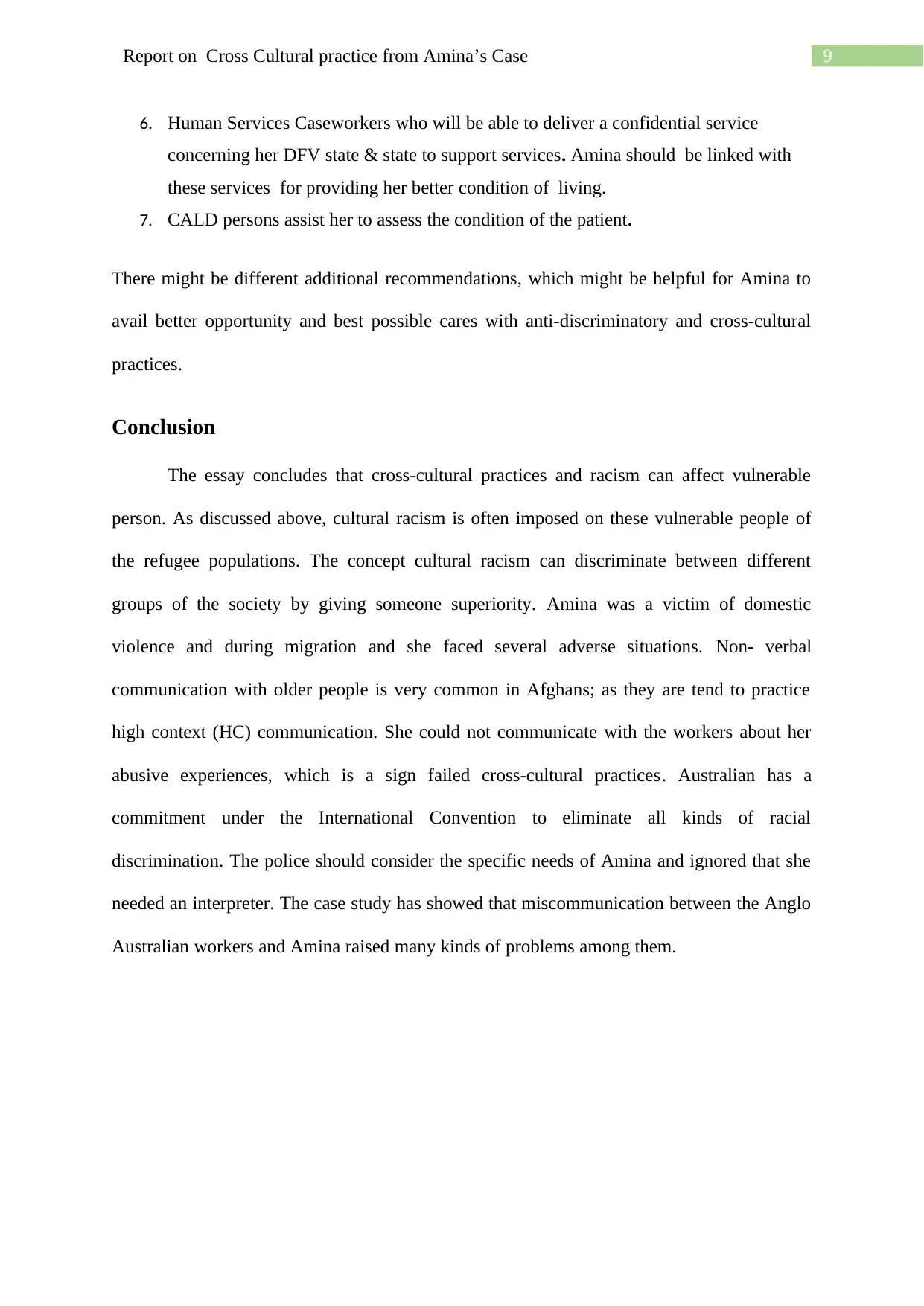
9Report on Cross Cultural practice from Amina’s Case
6. Human Services Caseworkers who will be able to deliver a confidential service
concerning her DFV state & state to support services. Amina should be linked with
these services for providing her better condition of living.
7. CALD persons assist her to assess the condition of the patient.
There might be different additional recommendations, which might be helpful for Amina to
avail better opportunity and best possible cares with anti-discriminatory and cross-cultural
practices.
Conclusion
The essay concludes that cross-cultural practices and racism can affect vulnerable
person. As discussed above, cultural racism is often imposed on these vulnerable people of
the refugee populations. The concept cultural racism can discriminate between different
groups of the society by giving someone superiority. Amina was a victim of domestic
violence and during migration and she faced several adverse situations. Non- verbal
communication with older people is very common in Afghans; as they are tend to practice
high context (HC) communication. She could not communicate with the workers about her
abusive experiences, which is a sign failed cross-cultural practices. Australian has a
commitment under the International Convention to eliminate all kinds of racial
discrimination. The police should consider the specific needs of Amina and ignored that she
needed an interpreter. The case study has showed that miscommunication between the Anglo
Australian workers and Amina raised many kinds of problems among them.
6. Human Services Caseworkers who will be able to deliver a confidential service
concerning her DFV state & state to support services. Amina should be linked with
these services for providing her better condition of living.
7. CALD persons assist her to assess the condition of the patient.
There might be different additional recommendations, which might be helpful for Amina to
avail better opportunity and best possible cares with anti-discriminatory and cross-cultural
practices.
Conclusion
The essay concludes that cross-cultural practices and racism can affect vulnerable
person. As discussed above, cultural racism is often imposed on these vulnerable people of
the refugee populations. The concept cultural racism can discriminate between different
groups of the society by giving someone superiority. Amina was a victim of domestic
violence and during migration and she faced several adverse situations. Non- verbal
communication with older people is very common in Afghans; as they are tend to practice
high context (HC) communication. She could not communicate with the workers about her
abusive experiences, which is a sign failed cross-cultural practices. Australian has a
commitment under the International Convention to eliminate all kinds of racial
discrimination. The police should consider the specific needs of Amina and ignored that she
needed an interpreter. The case study has showed that miscommunication between the Anglo
Australian workers and Amina raised many kinds of problems among them.
Paraphrase This Document
Need a fresh take? Get an instant paraphrase of this document with our AI Paraphraser
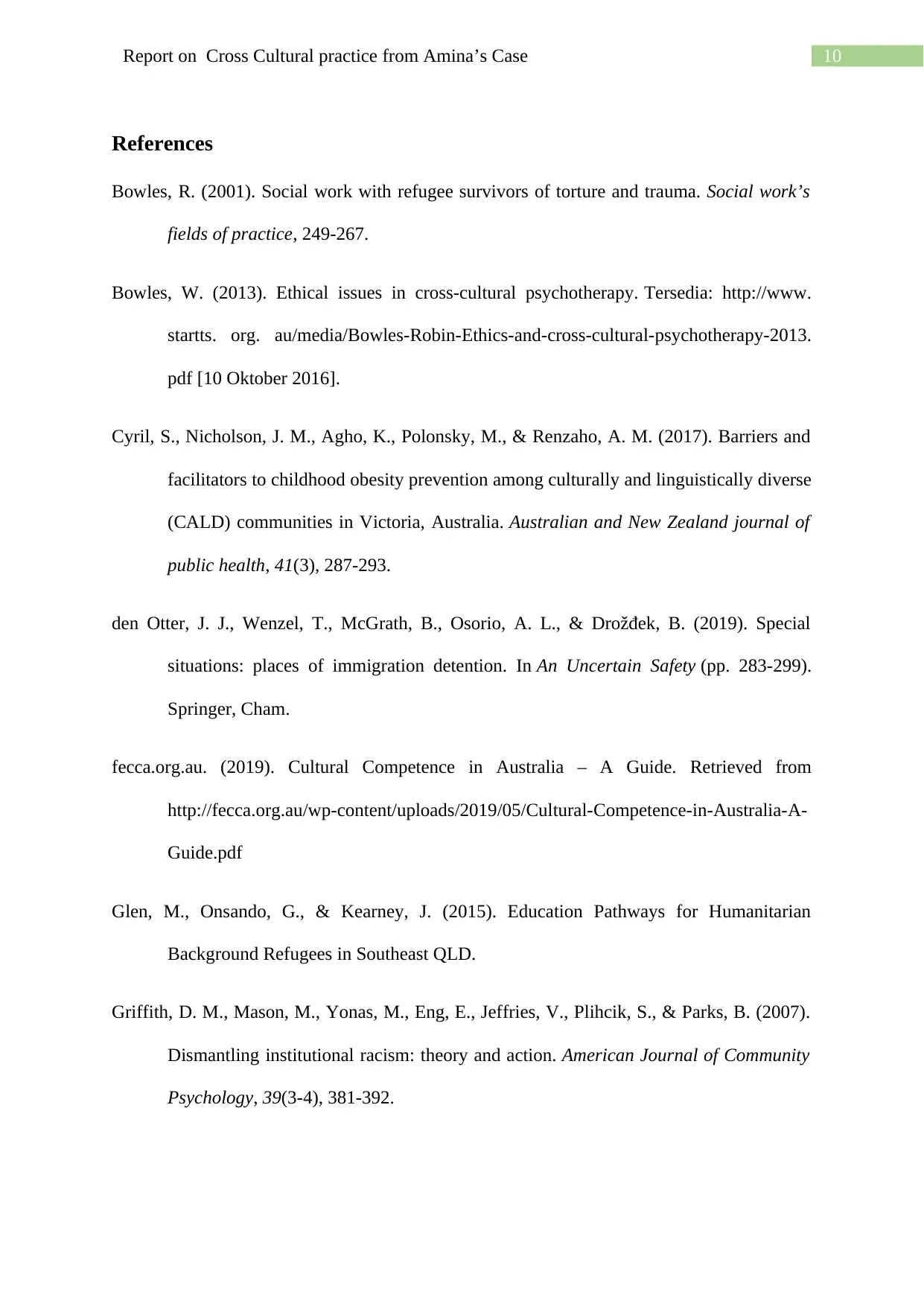
10Report on Cross Cultural practice from Amina’s Case
References
Bowles, R. (2001). Social work with refugee survivors of torture and trauma. Social work’s
fields of practice, 249-267.
Bowles, W. (2013). Ethical issues in cross-cultural psychotherapy. Tersedia: http://www.
startts. org. au/media/Bowles-Robin-Ethics-and-cross-cultural-psychotherapy-2013.
pdf [10 Oktober 2016].
Cyril, S., Nicholson, J. M., Agho, K., Polonsky, M., & Renzaho, A. M. (2017). Barriers and
facilitators to childhood obesity prevention among culturally and linguistically diverse
(CALD) communities in Victoria, Australia. Australian and New Zealand journal of
public health, 41(3), 287-293.
den Otter, J. J., Wenzel, T., McGrath, B., Osorio, A. L., & Drožđek, B. (2019). Special
situations: places of immigration detention. In An Uncertain Safety (pp. 283-299).
Springer, Cham.
fecca.org.au. (2019). Cultural Competence in Australia – A Guide. Retrieved from
http://fecca.org.au/wp-content/uploads/2019/05/Cultural-Competence-in-Australia-A-
Guide.pdf
Glen, M., Onsando, G., & Kearney, J. (2015). Education Pathways for Humanitarian
Background Refugees in Southeast QLD.
Griffith, D. M., Mason, M., Yonas, M., Eng, E., Jeffries, V., Plihcik, S., & Parks, B. (2007).
Dismantling institutional racism: theory and action. American Journal of Community
Psychology, 39(3-4), 381-392.
References
Bowles, R. (2001). Social work with refugee survivors of torture and trauma. Social work’s
fields of practice, 249-267.
Bowles, W. (2013). Ethical issues in cross-cultural psychotherapy. Tersedia: http://www.
startts. org. au/media/Bowles-Robin-Ethics-and-cross-cultural-psychotherapy-2013.
pdf [10 Oktober 2016].
Cyril, S., Nicholson, J. M., Agho, K., Polonsky, M., & Renzaho, A. M. (2017). Barriers and
facilitators to childhood obesity prevention among culturally and linguistically diverse
(CALD) communities in Victoria, Australia. Australian and New Zealand journal of
public health, 41(3), 287-293.
den Otter, J. J., Wenzel, T., McGrath, B., Osorio, A. L., & Drožđek, B. (2019). Special
situations: places of immigration detention. In An Uncertain Safety (pp. 283-299).
Springer, Cham.
fecca.org.au. (2019). Cultural Competence in Australia – A Guide. Retrieved from
http://fecca.org.au/wp-content/uploads/2019/05/Cultural-Competence-in-Australia-A-
Guide.pdf
Glen, M., Onsando, G., & Kearney, J. (2015). Education Pathways for Humanitarian
Background Refugees in Southeast QLD.
Griffith, D. M., Mason, M., Yonas, M., Eng, E., Jeffries, V., Plihcik, S., & Parks, B. (2007).
Dismantling institutional racism: theory and action. American Journal of Community
Psychology, 39(3-4), 381-392.
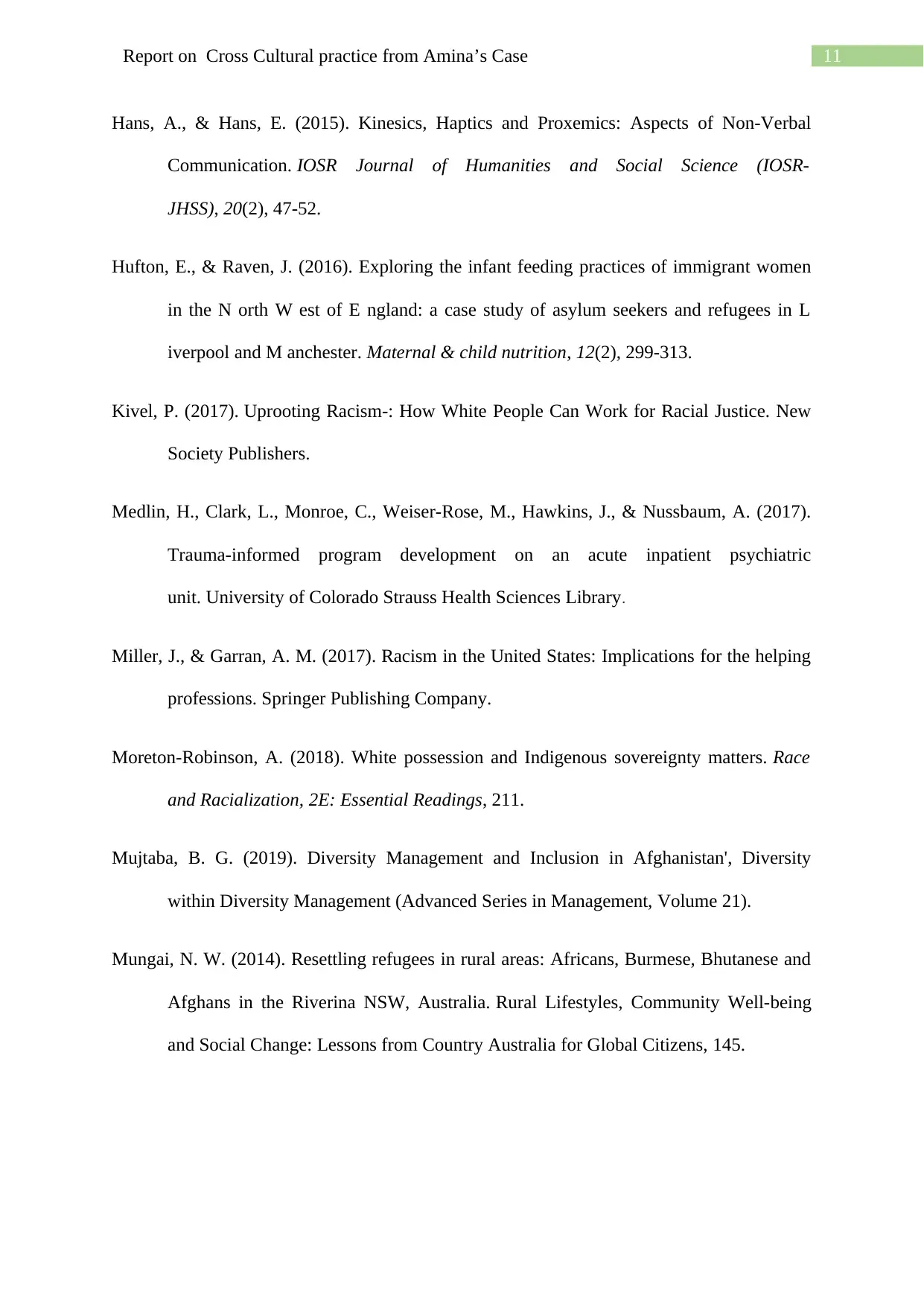
11Report on Cross Cultural practice from Amina’s Case
Hans, A., & Hans, E. (2015). Kinesics, Haptics and Proxemics: Aspects of Non-Verbal
Communication. IOSR Journal of Humanities and Social Science (IOSR-
JHSS), 20(2), 47-52.
Hufton, E., & Raven, J. (2016). Exploring the infant feeding practices of immigrant women
in the N orth W est of E ngland: a case study of asylum seekers and refugees in L
iverpool and M anchester. Maternal & child nutrition, 12(2), 299-313.
Kivel, P. (2017). Uprooting Racism-: How White People Can Work for Racial Justice. New
Society Publishers.
Medlin, H., Clark, L., Monroe, C., Weiser-Rose, M., Hawkins, J., & Nussbaum, A. (2017).
Trauma-informed program development on an acute inpatient psychiatric
unit. University of Colorado Strauss Health Sciences Library.
Miller, J., & Garran, A. M. (2017). Racism in the United States: Implications for the helping
professions. Springer Publishing Company.
Moreton-Robinson, A. (2018). White possession and Indigenous sovereignty matters. Race
and Racialization, 2E: Essential Readings, 211.
Mujtaba, B. G. (2019). Diversity Management and Inclusion in Afghanistan', Diversity
within Diversity Management (Advanced Series in Management, Volume 21).
Mungai, N. W. (2014). Resettling refugees in rural areas: Africans, Burmese, Bhutanese and
Afghans in the Riverina NSW, Australia. Rural Lifestyles, Community Well-being
and Social Change: Lessons from Country Australia for Global Citizens, 145.
Hans, A., & Hans, E. (2015). Kinesics, Haptics and Proxemics: Aspects of Non-Verbal
Communication. IOSR Journal of Humanities and Social Science (IOSR-
JHSS), 20(2), 47-52.
Hufton, E., & Raven, J. (2016). Exploring the infant feeding practices of immigrant women
in the N orth W est of E ngland: a case study of asylum seekers and refugees in L
iverpool and M anchester. Maternal & child nutrition, 12(2), 299-313.
Kivel, P. (2017). Uprooting Racism-: How White People Can Work for Racial Justice. New
Society Publishers.
Medlin, H., Clark, L., Monroe, C., Weiser-Rose, M., Hawkins, J., & Nussbaum, A. (2017).
Trauma-informed program development on an acute inpatient psychiatric
unit. University of Colorado Strauss Health Sciences Library.
Miller, J., & Garran, A. M. (2017). Racism in the United States: Implications for the helping
professions. Springer Publishing Company.
Moreton-Robinson, A. (2018). White possession and Indigenous sovereignty matters. Race
and Racialization, 2E: Essential Readings, 211.
Mujtaba, B. G. (2019). Diversity Management and Inclusion in Afghanistan', Diversity
within Diversity Management (Advanced Series in Management, Volume 21).
Mungai, N. W. (2014). Resettling refugees in rural areas: Africans, Burmese, Bhutanese and
Afghans in the Riverina NSW, Australia. Rural Lifestyles, Community Well-being
and Social Change: Lessons from Country Australia for Global Citizens, 145.
⊘ This is a preview!⊘
Do you want full access?
Subscribe today to unlock all pages.

Trusted by 1+ million students worldwide
1 out of 13
Related Documents
Your All-in-One AI-Powered Toolkit for Academic Success.
+13062052269
info@desklib.com
Available 24*7 on WhatsApp / Email
![[object Object]](/_next/static/media/star-bottom.7253800d.svg)
Unlock your academic potential
Copyright © 2020–2025 A2Z Services. All Rights Reserved. Developed and managed by ZUCOL.





